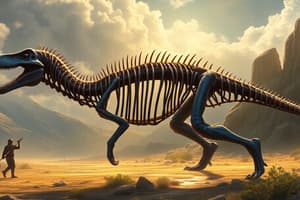Podcast
Questions and Answers
What is the main reason why fossils are considered the most direct evidence of evolution?
What is the main reason why fossils are considered the most direct evidence of evolution?
- Fossils offer insight into the geographic location of ancient species.
- Fossils provide information on the age of the Earth.
- Successive evolutionary changes can be observed when comparing old and young fossils. (correct)
- Fossils represent over 90% of all species that ever existed.
Why are fossils rare according to the text?
Why are fossils rare according to the text?
- Due to a high number of species that have ever lived on Earth.
- Because biological factors like the population of a species affect fossilization.
- Fossils require specific types of rock formations to become preserved.
- Geological factors such as habitat and geographic location play a role in fossil rarity. (correct)
How many fossil species have been discovered so far according to the text?
How many fossil species have been discovered so far according to the text?
- Around 300,000 (correct)
- Less than 100,000
- Approximately 500,000
- Over 1 million
What is the minimum age requirement for an organism to be considered a fossil?
What is the minimum age requirement for an organism to be considered a fossil?
Which of the following is NOT a biological factor that can affect fossilization?
Which of the following is NOT a biological factor that can affect fossilization?
Approximately how many T.rex fossils have been discovered according to the text?
Approximately how many T.rex fossils have been discovered according to the text?
What type of fossils are used to identify or define a geological period?
What type of fossils are used to identify or define a geological period?
Which fossilization process involves organic materials being replaced by minerals in bones and wood?
Which fossilization process involves organic materials being replaced by minerals in bones and wood?
What type of fossils are more or less complete organisms preserved in amber, tar, or ice?
What type of fossils are more or less complete organisms preserved in amber, tar, or ice?
Which type of fossil reflects animal behavior, locomotion, and diet?
Which type of fossil reflects animal behavior, locomotion, and diet?
What is the term for the process where a mold is formed after the organic material decomposes and minerals fill the space?
What is the term for the process where a mold is formed after the organic material decomposes and minerals fill the space?
Which type of fossilized remains show traits of both an ancestral group and a descendant group?
Which type of fossilized remains show traits of both an ancestral group and a descendant group?
What term is used in the text to describe 'transitional forms'?
What term is used in the text to describe 'transitional forms'?
Based on the text, what does 'Orthogenesis' suggest about the evolution of species?
Based on the text, what does 'Orthogenesis' suggest about the evolution of species?
What does the text mention as a factor that affects the possibility of cloning an extinct animal from a fossil?
What does the text mention as a factor that affects the possibility of cloning an extinct animal from a fossil?
What is the approximate half-life of DNA, as mentioned in the text?
What is the approximate half-life of DNA, as mentioned in the text?
Why is it impossible to clone non-avian dinosaurs directly from fossils, according to the text?
Why is it impossible to clone non-avian dinosaurs directly from fossils, according to the text?
How does the text describe the geographical distribution of species in isolated continents and islands?
How does the text describe the geographical distribution of species in isolated continents and islands?




